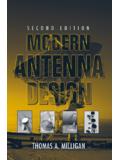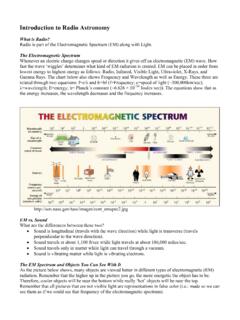Transcription of Amateur Radio Astronomy Projects — Radio Signals from …
1 Jon Wallace Richard Flagg, AH6NM. 111 Birden St, Torrington, CT 06790; 1721-1 Young St, Honolulu, HI 96826; Amateur Radio Astronomy Projects . Radio Signals from Jupiter You can receive Signals directly from the planet Jupiter, possibly by using equipment you already own. In 1955 mysterious Signals from space were discovered by Radio astronomers at the Carnegie Institution of Washington, DC. Some thought the Signals were local inter- ference, perhaps a noisy ignition system of a pickup truck whose driver was return- ing home from a late night date. However, analysis revealed that the planet Jupiter was in the beam of the Mills Cross antenna each time that Signals were heard.
2 Unlike many Radio Astronomy dish antennas, the huge Mills Cross comprised over 100 dipoles strung between wooden poles planted in a Maryland field. The dipoles were phased to produce a narrow, steerable, pencil-thin beam some in width. That is an amaz- ingly narrow beam considering the operat- ing frequency was MHz. Ever since this accidental discovery, researchers have aimed shortwave antennas at Jupiter as they attempted to understand the source of these Jupiter and Io. powerful Signals . Giant Jupiter, some 500 million miles these source regions is facing Earth, we from Earth, is a huge ball of gas with a small have an increased probability of receiving core of solid hydrogen, a strong magnetic Signals .
3 If the Jovian moon Io is in the right field, and a retinue of over 60 moons. The place in its orbit, the probability of receiving largest moons, Io, Europa, Ganymede and Signals is greatly enhanced. The moon Io Callisto, were first viewed by Galileo over happens to be within the tidal force's limit 400 years ago using his primitive telescope. of Jupiter and it is literally being torn apart Large enough to hold 1000 Earths, Jupiter by gravitational forces with tides as large as rotates about its axis every 10 hours a 100 meters (about 300 feet!). Io crosses the rotating speed demon compared to tiny magnetic field of Jupiter and is thus able to Earth and its 24-hour day.
4 Release charged particles into the field. These charges are accelerated to very high speed Signals Detected and spiral along magnetic field lines and The so-called decametric Radio Signals generate synchrotron radiation, which mani- from Jupiter are not on the air all the time Figure 1 Jupiter Radio noise bursts fests itself as the Radio Signals detected here received at MHz using a Jove receiver but seem to be linked to three longitude on Earth. There is additional data that sug- and dual dipole antenna. Signals are regions around the planet, cleverly named gests that Ganymede and Europa may also displayed using SkyPipe software. The the A, B, and C source regions.
5 If one of contribute to the Radio emissions. Earth's vertical axis is proportional to voltage. QEX May/June 2010 1. Figure 2 The Jove direct conversion receiver is simplicity itself with only two controls a POWER SWITCH/VOLUME CONTROL and a TUNING knob. Low level audio from the receiver is sent to a computer sound card and also may drive an amplified speaker. The receiver uses a J310 grounded gate RF amplifier followed by the traditional NE602 mixer/. oscillator and high gain audio amplifiers. A varicap tunes the receiver over a 400 kHz range centered on MHz. ionosphere limits ground based reception between the stations. below about 15 MHz and Jupiter itself does During a good storm, Jovian Signals can not emit these Signals above MHz an be easily heard, often several dB above the upper limit determined by the strength of the background noise.
6 Of course, the bigger Jovian magnetic field. your antenna the stronger the Signals . The So what do the Signals sound like? There 640-dipole, MHz, phased array antenna are two distinct types: L-bursts sound like at the University of Florida would yield sig- ocean waves breaking up on a beach, and nals well over 20 dB above the background. S-bursts, which can occur at rates of tens of bursts per second, sound like popcorn pop- Radio Jove ping or a handful of gravel thrown onto a Ten years ago a group of (mostly). tin roof. University of Florida graduates working at Have you heard them? Late at night is the NASA conceived an educational outreach best time, when the ionosphere has become program known as Radio Jove.
7 The idea was transparent and most terrestrial Signals have to build an inexpensive Radio telescope kit disappeared on the 15 meter band. The quiet suitable for detecting Signals from Jupiter. hiss in your headphones comes mostly from The Jove receiver (Figure 2) is a simple relativistic electrons spiraling in the galactic direct-conversion design operating over a magnetic field. L-bursts and S-bursts are few hundred kilohertz range centered at heard above this background noise. A Radio Figure 3 Here is a block diagram of the MHz. The block diagram is shown in Radio Jove receiver. noise storm of L- or S-bursts can last from a few minutes to a couple of hours (Figure 1).
8 Do you need a giant antenna spread out over several acres? Fortunately not a ham band Yagi will do very nicely. Even if Jupiter is 30 or 40 above your horizon, a low- mounted Yagi aimed toward the azimuth of Jupiter will probably have adequate gain. And you don't need a cryogenically-cooled front Sources for Jupiter Radio Supplies and Information end either; your favorite ham-band receiver is plenty sensitive. Just be sure to turn the AGC Radio Jove Web site: off, as AGC can severely distort the Jovian Jim Sky's Radio Jupiter Central site: noise bursts. Probably the best frequency Jim Sky's Radio Sun Central site: range is between 18 and 22 MHz, so if you The Society of Amateur Radio Astronomy (SARA): are using a ham-band only receiver, try the 15 or 17 meter bands.
9 Either AM or SSB. modes will work. Just tune for a quiet spot 2 QEX May/June 2010. (A). (B). Figure 4 The Jove dual dipole array. Dipoles are suspended between PVC masts. Signals from the dipoles go to a power combiner and then to the receiver. QEX May/June 2010 3. Figure 5 A single shark fin shaped solar burst. Activity has been sparse during the long solar minimum but as we head toward maximum there will be many opportunities to hear solar bursts. On occasion, following Figure 6 Radio spectrogram of Jupiter Radio noise storm activity. Horizontal lines are weak a strong burst the background noise will stations while Jovian Signals are seen as the enhanced region between and MHz.
10 Decrease, indicating increased absorption Any resemblance between this emission region and the shape of the starship Enterprise is in the earth's ionosphere due to enhanced purely coincidental. solar X-ray and UV flux. Figure 3. The antenna is a dual dipole array Type IV Flare-related broad-band con- Jon Wallace has been a high school sci- (Figure 4). Audio Signals from the receiver tinua. ence teacher in Meriden, Connecticut for are sent to a computer sound card where they Type V Broad-band continua that may over 28 years. He is past president of the are processed and displayed as a strip-chart appear with Type III bursts. Last 1 to 2 min- Connecticut Association of Physics Teachers record using SkyPipe software.




